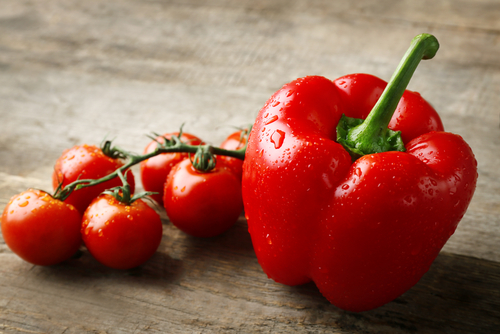For the last 10 years or so, the media has hyped superfoods. Foods like chia seeds, kale and quinoa, if eaten on a regular basis, are supposed to radically benefit our health. And while these superfoods do offer many health benefits, there are other common fruits and vegetables that should be getting more attention for their ability to not only create optimum health but assist in weight loss as well.
You may think fruits and veggies help us lose weight because they are lower in calories. And while that’s true, the mechanism is more entailed. You see, fruits and veggies have powerful elements inside of them called flavonoids. These flavonoids are what give produce its red, green and purple colors.
What Are Flavonoids Exactly?
Flavonoids are one of the biggest nutrient families known in the scientific community and include quercetin, kaempferol, catechins, and anthocyanidins. These nutrients are best known for their antioxidant and anti-inflammatory benefits. Unfortunately, these nutrients, though powerful, are also quite delicate and can be destroyed when vegetables are overcooked. This is why it’s important to eat as many raw fruits and veggies as you can, to protect their beneficial nutrients.
We know from various studies that flavonoids are a powerful foe against inflammation and resulting diseases such as cancer, neurodegenerative and cardiovascular diseases. But a new study, published in BMJ, found that flavonoids are also important fighters in the battle of the bulge.
The study followed more than 120,000 men and women to observe the effects of eating certain types and amounts of flavonoids. This study went on for two decades and each participant reported their weight, habits, and any diagnosed diseases every two years during this time period.
“We looked at seven different classes of flavonoids, and we found increased consumption was associated with less weight gain,” said study author Monica Bertoia, a research associate at the Harvard T.H. Chan School of Public Health in Boston, in a news release.
While dietitians and medical professionals have always agreed that adding fruits and vegetables enriched in flavonoids can benefit your health, this study shows how beneficial flavonoid-rich foods are to maintaining a healthy weight. The study concluded that eating foods high in flavonoids can prevent obesity and help adults maintain a heathy weight.
Researchers suggest that everyone should consume at least two cups of fruit and 2.5 cups of vegetables each day. By filling your plate with more fruits and vegetables and less meats and processed foods, you will control your weight while decreasing your chances of developing diabetes, high cholesterol and cancer.
6 Foods Rich in Flavonoids
Now that you know that these powerful nutrients can help you lose weight and keep it off, let’s take a look at some of the foods offering the highest levels of flavonoids.
Tree Fruits
Fruits that grow on trees such as bananas and citrus fruits have been shown to be high in flavonoids. Bananas contain anthocyanidins including cyanidin and delphinidin, while citrus fruits including lemons, limes, oranges and grapefruit are high in hesperetin, naringenin and eriodictyol. Apples, pears, plums, peaches and apricots are known to be high in catechin and epicatechin. To receive the biggest benefits, these fruits should be eaten raw with skins on.
Nuts and Beans
In addition to being a rich source of protein, some nuts and beans are also high in flavonoids. As with berries, dark beans such as black and kidney beans are typically higher in flavonoids such as delphinidin, malvidin, petunidin and kaempferol. Beans consumed in their immature forms, like pinto and fava, are rich in flavonols such as epicatechin and epigallocatechin.
Many nuts are great sources of flavonoids. Pecans and walnuts are high in anthocyanidins, and pistachios and cashews are high in the flavonols catechins.
I should remind you that although nuts are high in flavonoids, they are still very high in fat, and hence, calories, so watch how many nuts you eat per serving.
Berries
Berries are not only delicious, they are also loaded with flavonoids, particularly red, blue and purple berries. Typically, the darker the berry, the higher concentration of flavonoids.
Blueberries and cranberries are rich in quercetin and myricetin. Blackberries and black grapes are high in the flavonoids epicatechin and catechin while raspberries, cherries and red grapes may be high in anthocyanidins and cyanidin.
Red and Green Vegetables
While most vegetables contain flavonoids, it’s green and red veggies that offer the highest concentrations. Members of the nightshade family including eggplants, tomatoes and peppers are high in quercetin and luteolin. Onions, especially red and green onions, are also high in quercetin.
Green veggies such as artichokes and celery are high in the flavones apigenin and luteolin, while snap beans, okra and broccoli are high in flavonols including quercetin, kaempferol and myricetin.
Spices
Spices don’t just make food taste better; they make it healthier as well. Certain spices are particularly high in flavonoids and offer the most benefits when eaten fresh, not dried. Dill offers high concentrations of the flavonols quercetin and isorhamnetin while parsley is high in apigenin along with isorhamnetin. Thyme is a rich source of the flavones luteolin and capers, which are an acquired taste for many, are very high in the flavonols kaempferol and quercetin.
Beverages
While processed fruit juices you buy at your local grocery store are typically loaded with fructose corn syrup, juices you make yourself from raw fruits such as berries and grapes are excellent sources of flavonoids. Red wine also offers the benefits of grape juice including high concentrations of anthocyanidins and the flavonols quercetin and myricetin.
Various black, red, and green teas have been shown to be high in catechins such as epigallocatechin along with related flavonols such as thearubigin.
While increasing your intake of fruits and veggies can help you lose weight, not many people can or should subsist on produce alone. So how can you lose weight while eating other food groups? Is there a natural way to eat “normal” foods and still lose weight?
Absolutely!
Find out how you can eat your favorite forbidden foods without packing on the pounds. If you’ve never heard of resistant starch, you’re about to find out how simple and natural weight loss can be.
 Validating...
Validating... 







2 Comments